 Diagnose & Repair Poor Municipal Water Pressure
Diagnose & Repair Poor Municipal Water Pressure
or Lost Municipal Water Pressure
- POST a QUESTION or COMMENT about troubleshooting poor or no city water pressure
Municipal or city water pressure troubleshooting:
Causes of poor water pressure or water flow rate. Cures for poor water pressure or flow rate in a building with city water supply.
This article describes how to diagnose and how to correct poor city water pressure or flow, and why to distinguish among intermittent water pressure loss, total water pressure loss, and poor water pressure or flow in a building.
InspectAPedia tolerates no conflicts of interest. We have no relationship with advertisers, products, or services discussed at this website.
- Daniel Friedman, Publisher/Editor/Author - See WHO ARE WE?
How to Diagnose & Correct Poor Municipal Water Supply Pressure
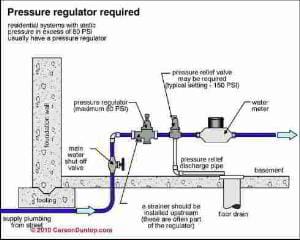 Our discussion is divided into water pressure loss symptoms and diagnostic steps
Our discussion is divided into water pressure loss symptoms and diagnostic steps
for MUNICIPAL WATER PRESSURE DIAGNOSIS
and separately, WELL WATER PRESSURE DIAGNOSIS - we give procedures for both municipal water supply problems and well water supply problems.
The process of diagnosis and the costs of the repair when municipal water supply, quantity, or flow are poor are explained here.
Readers whose buildings are served by municipal water supply systems that simply don't deliver good water pressure should
see MUNICIPAL WATER PRESSURE IMPROVEMENTS.
For buildings so tall that water pressure is poor on upper floors should also
see WATER PRESSURE BOOSTER PUMP.
Who Is Responsible for the Water Service Piping Between Building and City Water Main?
The underground water service line from the property line to the house is owned by the homeowner.
Beyond the property line, the pipe is the responsibility of the city. A leak in the pipe requires excavation, and it is often difficult to know whether the leak is on the city’s or the homeowner’s side.
The city is usually contacted and they excavate their section of the pipe, correcting the problem if they discover it. If no problem is found, the homeowner is left to correct the problem on his or her own. In some cases, the homeowner must pay for the city’s work if the city pipe is not at fault.
Some municipalities use sophisticated leak detection equipment.
Step by Step Guide to Diagnosing Bad City Water Pressure or Flow
Our sketch (below left) courtesy of Carson Dunlop Associates, shows the key components found where municipal water supply enters a building.- Double check that there are no running fixtures nor burst pipes and no water supply piping leaks in the building interior water piping.
A quick check to be sure there are no in-building pipe leaks or running fixtures is an important first step in diagnosing bad water pressure and flow. - Check to see if there are leaks or crimps in the water supply pipe between the building and the water main in the street,
and that there and no water running elsewhere before going on to more complicated water pressure diagnosis steps.
The Home Reference Book points out that since the supply line from the street cannot be seen, no comment is offered during a home inspection. If there is a leak, it may go undetected for some time.
In some cases, water can be heard running outside the basement wall. Water accumulating in the basement or a wet spot on the lawn is often the first indication.
Leaks may be caused by building settlement, excavation, poor connections, faulty valves or a flaw in the pipe itself. - Listen for water supply main leaks:
If your water is from a municipal supply and if you can turn off water right at the entry to your building, you can then listen to the piping - you may discover that there is an underground water main supply leak outside!
Turn off the main water shutoff valve where water is entering the building (sketch at left) and listen to the water pipe on the street side of the incoming water shutoff valve (use a mechanic's stethoscope) by checking the water piping for a sound of running water. - Check the city water supply main pressure and flow:
Ask your plumber to measure the incoming water pressure and flow before the water pressure regulator,or with the pressure regulator set wide open.
See details at WATER PRESSURE MEASUREMENT
Poor water pressure in the house may be the result of a partially closed or obstructed valve in the street. It may also be because of blockage, such as a stone or other foreign body in the pipe.
Also see WATER PRESSURE GAUGE ACCURACY since a bad gauge can fool you. - Check the building water pressure regulator / water pressure reducing valve settings: If your municipal water supply system includes a water pressure regulator, it is usually located quite close to the incoming water supply pipe and the main water shut off valve.
Water pressure regulators can be adjusted to improve water pressure in the building but don't overdo it or you may get leaks
See WATER PRESSURE REDUCER / REGULATOR for details.
A typical city water pressure regulator found in buildings is shown at the top of This article . - Water supply piping buried outdoors must be bedded in clean sand.
Where copper water supply pipes have been buried in gravel, contractors find that over time the gravel, perhaps moving by frost or water passage through the soil, actually works against the metal water piping to create multiple holes and leaks in the water main.
New water supply piping recently installed between the building and the street (or even old piping) may be crimped during installation or become pinched under a rock during back-filling operations. This can also cause low water pressure.
One of our consultants, George from Jeneral Sewer Service reported that on excavating a water supply line with poor water pressure, he found that the entire length of the copper water pipe had multiple perforations - "When we dug it up and turned on water pressure at the curb box the water line looked like a sprinkler hose!" he said.
Where plastic water supply piping is used the risk of gravel perforation from the backfill material is little or none unless the excavator permits a large or sharp stone to become buried close to the pipe. - Poor incoming water pressure from a community or municipal water supply?
How to boost water pressure in a building by installing a pressure booster pump and pressure tank for buildings whose incoming water pressure is too low or intermittent is discussed in detail
at WATER PRESSURE BOOSTER PUMP.
City water mains may be undersized or deteriorated in older neighborhoods.
Some cities have poor pumping and/or distribution systems.
In these cases, low water pressure problems are usually experienced at every home in the neighborhood. The long-term solution is to petition the city to improve its system. 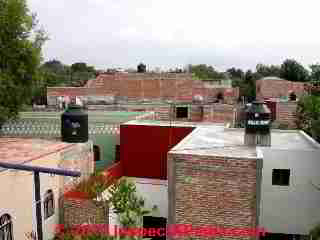 How to handle intermittent loss of community water pressure: many communities do not supply water through the municipal water piping system all day every day, depending on usage, weather, and other conditions.
How to handle intermittent loss of community water pressure: many communities do not supply water through the municipal water piping system all day every day, depending on usage, weather, and other conditions.
Owners of buildings served by intermittent municipal water supply systems usually solve this problem by providing a local cistern or water storage tank, often on the building roof or at a high level.
Our photo (left) shows two Aquaplas™ rooftop water storage tanks found in San Miguel de Allende, Guanajuato, Mexico.
The water tank is fed by municipal water when it is available, and the local building water storage tank assures that water is available in the building 24-hours a day.
Local water storage tanks and cisterns may work by gravity or they may use a water pressure booster pump.
The rooftop water tanks in our photo are working by gravity alone and are fed municipal water piped from the street below.
Where owners in this neighborhood desire high-pressure showers, they have added a booster pump to their rooftop water storage system.
For details see WATER PRESSURE BOOSTER PUMP
Other properties use a ground-level cistern combined with a pump to lift water into the building.
At PASSIVE SOLAR HOME, LOW COST we describe a home using a combination of rooftop rainwater collection and municipal water piped into a storage tank.- Poor water pressure due to building height? How to boost water pressure in a building by installing a pressure booster pump and pressure tank for tall buildings is discussed in detail
at WATER PRESSURE BOOSTER PUMP - Poor municipal water pressure/flow history helps diagnose the cause:
- Poor water flow at your building only: if water pressure at your building is the same as neighbors, but your building water flow rate is worse than neighbors, it is possible that water supply piping between the building and the street was pinched, crimped, damaged (or even leaking) since its installation.
Leaks can also occur after buried water piping was installed if sharp rocks or vehicle traffic over the piping cause a puncture. - Poor water pressure/flow in the neighborhood: If all of the homes in your neighborhood have poor water pressure or flow, the city water main may be undersized.
As we mentioned above, Carson Dunlop Associates Home Reference Book points out that some city water mains may be undersized or deteriorated in older neighborhoods, or the city may have poor pumping and/or distribution systems.
For a more immediate fix in municipal water pressure see WATER PRESSURE BOOSTER PUMP.
In most new housing, the supply pipe from the street to the house is 3/4-inch diameter.
- Poor water flow at your building only: if water pressure at your building is the same as neighbors, but your building water flow rate is worse than neighbors, it is possible that water supply piping between the building and the street was pinched, crimped, damaged (or even leaking) since its installation.
- Bad City Water Pressure due to Clogged or Crimped Building Supply Piping?
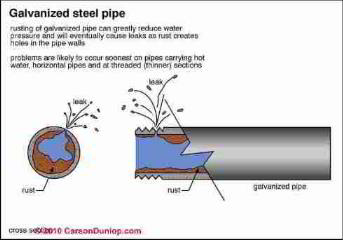
Poor water Even municipal water supplied in some communities can be "hard" or high in mineral content, iron content, or other ingredients that lead to clogged water piping.
Our sketch (left) courtesy of Carson Dunlop Associates, shows how rust can clog steel water supply piping.
If incoming water pressure is high - say over 40 psi, but water pressure falls off almost immediately when you open a faucet and remains poor, there may be a clog somewhere in your piping system, or worse, in most of it.
This condition usually develops over a long time - years - and does not change suddenly on its own.
Since bad water pressure or flow can be a piping pinch or leak problem rather than a municipal supply quantity or pressure problem, also
see PIPING in BUILDINGS, CLOGS, LEAKS, TYPES
and PLASTIC PIPE LEAK CAUSES.
Driving over water supply piping that is not properly bedded in sand or not buried at a safe depth can cause leaks or crimps in piping. Even if the buried water pipe is not leaking, if it has been crimped or crushed water pressure and flow into the building will be reduced.
Readers should also see WATER PIPE CLOG DIAGNOSIS
and WATER PIPE CLOG REPAIR.
Also see WATER PRESSURE LOSS DIAGNOSIS & REPAIR in a building
and see MUNICIPAL WATER PRESSURE DIAGNOSIS (this article)
or WELL WATER PRESSURE DIAGNOSISwhere we describe the effects of clogged piping on water flow and offer remedies for this problem.
If only hot water pressure and flow are poor, also
see CLOGGED SUPPLY PIPES, HOT WATER. - Small Diameter in-Building Water Supply Piping also Limits Water Flow Rate:
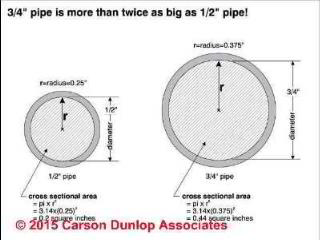 Even if the municipal water supply pressure is good and there is a good diameter water service pipe between the city water main and the building, small in-building water piping diameter may be a problem.
Even if the municipal water supply pressure is good and there is a good diameter water service pipe between the city water main and the building, small in-building water piping diameter may be a problem.
A building using 1/2" diameter piping, especially if the incoming water pressure is modest, or if the building has extensive lengths of water supply piping, perhaps combined with many elbows and tees, will suffer reduced water flow at its fixtures.
In most new housing, the supply pipe from the street to the house is 3/4-inch diameter. In older houses, the piping was as small as 3/8-inch.
Modern life styles and additional plumbing fixtures usually require a larger line, capable of providing more pressure and volume.Replacing this pipe is an expensive and disruptive job. It is often deferred as long as possible.
- Shared city water supply line?
Carson Dunlop Associates Home Reference Book points out that in some cities multiple homes may share a single supply line. In some older semi-detached (attached) and row houses, a single supply line would run under a front lawn, and then split to feed two houses.
This often yields unsatisfactory water pressure for both houses and is often replaced with two larger, separate lines. - Poor hot water pressure, acceptable cold water pressure at all fixtures? This condition often indicates clogging in the hot water piping or if a tankless coil is used to make hot water, clogging there.
If hot water pressure is noticeably worse than cold water pressure and flow at all fixtures, the problem may be due to sludge in the water heater or mineral-clogged piping or tankless coil
See details at TANKLESS COILS
A water softener won't fix mineral-clogged piping, but once that problem has been taken care of, it can prevent future clogs. Sludge build-up in a water heater can lead to poor hot water pressure.
Details are at WATER SOFTENERS & CONDITIONERS
The water heater tank should be flushed every year or so.
See CLOGGED SUPPLY PIPES, HOT WATER
or WATER HEATER SCALE DE-LIMING PROCEDURE.
See HOT WATER IMPROVEMENT especially if the building cold water pressure is acceptable but hot water pressure and flow are poor.
Accumulated debris in a water heater, and debris from a corroded or disintegrating hot water tank dip tube or hot water tank sacrificial anode can also block the hot water outlet opening, resulting in low hot water pressure in a building. - Clogged water treatment equipment or water filters:
A water softener and some other water treatment equipment, including water filters, especially if not well maintained, can also adversely affect water pressure.
See WATER FILTERS, HOME USE
and WATER SOFTENER ADJUSTMENT & CONTROLS. -
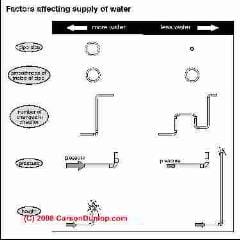 Poor water pressure just at certain plumbing fixtures?
Poor water pressure just at certain plumbing fixtures?
Poor cold water pressure, hot water pressure, or both hot and cold water pressure or flow that is observed just at some plumbing fixtures in a building while flow and quantity are good at others suggests that the water flow or pressure problems are local to certain runs of supply piping or to the specific fixtures.
Remember to check water pressure at all fixtures in all building areas.
On occasion you'll find more than one plumbing fixture with bad water pressure and flow, but the problem may simply be that each of those fixtures needs repair:
a clogged sink strainer and a broken o-ring in a shower head can mean that both of those fixtures have poor water pressure but the actual water supply system may be fine. - Thanks to reader Carole Cimitile.
The sketch at left, courtesy of Carson Dunlop Associates, shows five factors that affect the water pressure and flow in a building. Check the following first:- Clogged aerator or strainer on sink faucets
clogging by dirt, debris, corrosion, can significantly reduce both hot and cold water flow at a sink where the strainer needs cleaning or replacement.
Unscrew the strainer from the faucet and turn on the water - if the fixture pressure or flow is much better you've probably found the problem.
Look at the aerator/strainer: inspect it, clean it, perhaps soaking it overnight in vinegar to remove corrosion and mineral build-up, or just install a new aerator/strainer.
Check for clogged wire strainers found in the female end of hose fittings such as at a washing machine water supply hose and in some garden hoses. - Broken O-Rings on individual faucets -
can clog the faucet internals and prevent good water flow.
If just hot water or just cold water flow is weak at an individual fixture you or your plumber should check for and repair any damaged faucet parts. - Clogs in individual plumbing pipes, valves, elbows -
can occur during construction if copper pipe soldering is not performed properly.
Pushing too much solder into a copper pipe joint can result in weak flow and reduced pressure at all of the fixtures downstream from that fitting, even if the rest of the piping system is in good condition.
You may need help from a plumber to diagnose this problem, but if your water supply piping is not clogging from mineral deposits throughout, and if flow and pressure are bad just at some fixtures, this could be the problem.
Of course if an installer makes this soldering error on copper pipe joints near the beginning of a water supply piping system in a building, all of the fixtures downstream from that point will be affected, possibly all of the fixtures in the building. If mineral clogging might be a problem in the pipes in your building,
see WATER PIPE CLOG DIAGNOSIS. - Slow toilet fill: check for clogging in the toilet fill control valve assembly - perhaps easiest is to try swapping in a new fill valve to see if the toilet fill-up speeds up.
- Clogged or closed water valves: Remember also to check for partly-closed or clogged water shutoff valves at individual plumbing fixtures as well as at the main building water shutoff valve.
- Clogged aerator or strainer on sink faucets
- Problems with a municipal water pressure booster pump?
If your building uses a local water pressure tank and pump to boost water pressure in the building or at upper building floors there may be a problem with the pump, pump controls, or pressure tank.
Use the same diagnostic procedures for these components found in our private water supply system problems
at WELL WATER PRESSURE DIAGNOSIS
or take a look at these water pressure articles:
WATER PRESSURE BOOSTER PUMP
WATER PUMP CAPACITIES TYPES RATES GPM
WATER PUMP CONTROLS & SWITCHES
WATER TANK TYPES: WATER, OIL, EXPANSION, ALL - Poor water pressure in large buildings just at certain times of the day? Variations in building occupancy levels:
Where building demand for water flow varies widely, a single pressure reducing valve may not be able to handle the maximum water demand flow rate.
This condition occurs at buildings where there is a large water supply main to an apartment or office building whose water demand can vary enormously (0.5 gpm to 100 gpm) depending on the building occupants. Watts and other pressure reducing valve producers recommend a nice solution to this problem.
As we explain at WATER PRESSURE REDUCER / REGULATOR, parallel pressure reducing valves are sometimes installed to correct this difficulty. - Take These Extra Steps to Boost City Water Pressure & Flow at a Building:
after first diagnosing the problem and ruling out the leaks, crimps, or repairs needed by the steps we have described above, you can adjust the water pressure regulator, install a water pressure booster pump in the building, or install larger diameter water service or in building water supply piping.
...
Continue reading at MUNICIPAL WATER PRESSURE IMPROVEMENTS or select a topic from the closely-related articles below, or see the complete ARTICLE INDEX.
Or see MUNICIPAL WATER PRESSURE DIAGNOSIS FAQs - questions & answers about diagnosing weak city water pressure, posted originally at this page
Or see these
Municipal Water Pressure Articles
- CLOGGED SUPPLY PIPES, HOT WATER
- MUNICIPAL WATER PRESSURE DIAGNOSIS - home
- MUNICIPAL WATER PRESSURE IMPROVEMENTS
- WATER PRESSURE REDUCER / REGULATOR
- WATER PRESSURE BOOSTER PUMP
- WATER PRESSURE IMPROVEMENT
- WATER PRESSURE REDUCER / REGULATOR
Suggested citation for this web page
MUNICIPAL WATER PRESSURE DIAGNOSIS at InspectApedia.com - online encyclopedia of building & environmental inspection, testing, diagnosis, repair, & problem prevention advice.
Or see this
INDEX to RELATED ARTICLES: ARTICLE INDEX to WATER SUPPLY, PUMPS TANKS WELLS
Or use the SEARCH BOX found below to Ask a Question or Search InspectApedia
Ask a Question or Search InspectApedia
Questions & answers or comments about troubleshooting poor or no city water pressure.
Try the search box just below, or if you prefer, post a question or comment in the Comments box below and we will respond promptly.
Search the InspectApedia website
Note: appearance of your Comment below may be delayed: if your comment contains an image, photograph, web link, or text that looks to the software as if it might be a web link, your posting will appear after it has been approved by a moderator. Apologies for the delay.
Only one image can be added per comment but you can post as many comments, and therefore images, as you like.
You will not receive a notification when a response to your question has been posted.
Please bookmark this page to make it easy for you to check back for our response.
IF above you see "Comment Form is loading comments..." then COMMENT BOX - countable.ca / bawkbox.com IS NOT WORKING.
In any case you are welcome to send an email directly to us at InspectApedia.com at editor@inspectApedia.com
We'll reply to you directly. Please help us help you by noting, in your email, the URL of the InspectApedia page where you wanted to comment.
Citations & References
In addition to any citations in the article above, a full list is available on request.
- Mark Cramer Inspection Services Mark Cramer, Tampa Florida, Mr. Cramer is a past president of ASHI, the American Society of Home Inspectors and is a Florida home inspector and home inspection educator. Mr. Cramer serves on the ASHI Home Inspection Standards. Contact Mark Cramer at: 727-595-4211 mark@BestTampaInspector.com
- John Cranor [Website: /www.house-whisperer.com ] is an ASHI member and a home inspector (The House Whisperer) is located in Glen Allen, VA 23060. He is also a contributor to InspectApedia.com in several technical areas such as plumbing and appliances (dryer vents). Contact Mr. Cranor at 804-873-8534 or by Email: johncranor@verizon.net
- Thanks to Jeneral Sewer Service - George - 845-297-2285, a New York Hudson Valley drain and sewer cleaning and de-clogging expert for technical details and consulting on drain clog diagnosis and repair, including proper use of the Kinetic Water Ram for drain clearing - 3/14/2009
- Thanks to our reader, Carole Cimitile, 2/17/2009, for reminding us that small problems like faucet o-rings, clogged faucet strainers and similar local plumbing fixture defects can have a big impact on hot water flow, cold water flow, or both hot and cold water flow and pressure problems.
- Thanks to reader EK Woodard, Boise State University, Boise ID, for assistance in diagnosing poor water pressure following an electrical power loss. 3/14/2010
- Thanks to reader Regina Craig for discussing water pressure loss diagnosed as due to water filter clogging 6/25/2009
- Thanks to reader Carole Cimitile, for pointing out that bad water pressure and flow can occur at multiple fixtures at once when multiple fixture repairs are needed - it's not necessarily a clogged pipe or other water system problem. Feb 2009.
- Our recommended books about building & mechanical systems design, inspection, problem diagnosis, and repair, and about indoor environment and IAQ testing, diagnosis, and cleanup are at the InspectAPedia Bookstore. Also see our Book Reviews - InspectAPedia.
- In addition to citations & references found in this article, see the research citations given at the end of the related articles found at our suggested
CONTINUE READING or RECOMMENDED ARTICLES.
- Crystal Clear Supply provides portable ceramic water filter purifiers and portable reverse osmosis water treatment equipment - see http://www.crystalclearsupply.com/category_s/7.htm
- In addition to citations & references found in this article, see the research citations given at the end of the related articles found at our suggested
CONTINUE READING or RECOMMENDED ARTICLES.
- Carson, Dunlop & Associates Ltd., 120 Carlton Street Suite 407, Toronto ON M5A 4K2. Tel: (416) 964-9415 1-800-268-7070 Email: info@carsondunlop.com. Alan Carson is a past president of ASHI, the American Society of Home Inspectors.
Thanks to Alan Carson and Bob Dunlop, for permission for InspectAPedia to use text excerpts from The HOME REFERENCE BOOK - the Encyclopedia of Homes and to use illustrations from The ILLUSTRATED HOME .
Carson Dunlop Associates provides extensive home inspection education and report writing material. In gratitude we provide links to tsome Carson Dunlop Associates products and services.

